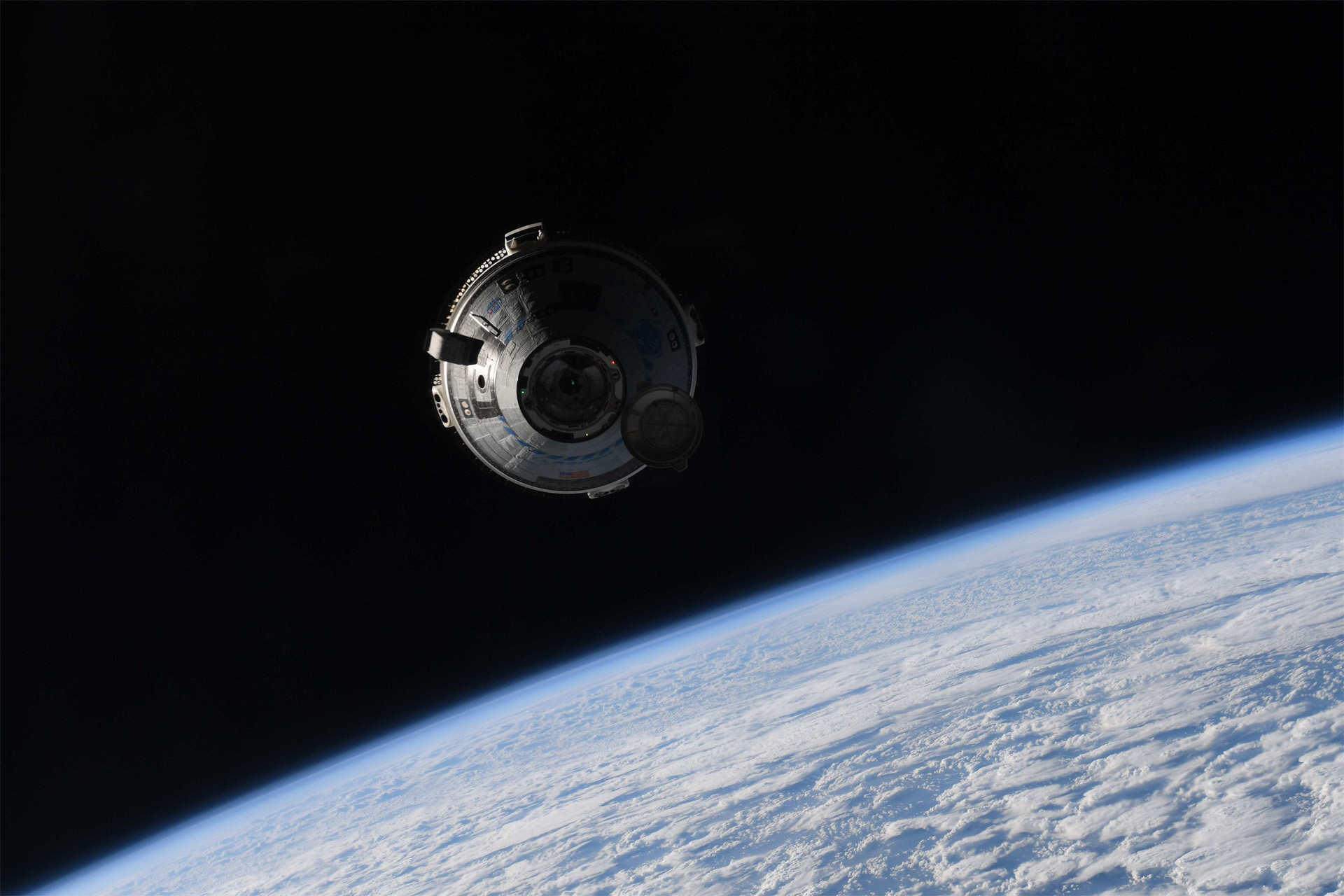Boeing and NASA launched the company's Starliner astronaut taxi on a crucial uncrewed mission to the International Space Station on May 19, 2022. It touched down safely on May 25, 2022 and the company is now working on getting a crewed spaceflight ready.
Orbital Flight Test-2 (OFT-2) lifted off from Space Launch Complex 41 at Cape Canaveral Space Force Station in Florida on a United Launch Alliance Atlas V rocket. OFT-2 was originally supposed to fly in August 2021, but an issue with some valves in Starliner's propulsion system pushed things back more than eight months.
This is Boeing's second time launching Starliner on an uncrewed test flight; the first mission, OFT-1, returned to Earth early after it failed to reach the space station in December 2019. NASA conducted major reviews of the Starliner program and identified a total of 80 corrective actions that Boeing needed to take before Starliner could return to flight.
Starliner docked with the International Space Station about 24 hours after it launched, and returned to Earth in late May with a parachute-assisted landing at White Sands Space Harbor in New Mexico.
Check back here for live updates on Starliner's development.
Landing webcasts | Mission photos | OFT-2 explained | Boeing News

Elizabeth Howell (Ph.D.) has been covering human spaceflight since 2004. She has watched five International Space Station human missions live from Florida and Kazakhstan and written about many of them in her book, "Canadarm and Collaboration."
Boeing invites students to send artwork aboard future Starliner missions
Wow, Julian! Great drawing of your dad working on #Artemis! We're grateful for his dedication and will pack this onto #Starliner for its next flight.“Art In The Stars” will transport digital submissions to @Space_Station. 🎨✨Submit your work here: https://t.co/TbutkPbM9U pic.twitter.com/wbS4H2EBAXNovember 25, 2022
Student artists may be able to fly their handiwork to space. Boeing is offering a new opportunity, "Art in the Stars", that will bring the art (in digital form) on a future Starliner spacecraft. More details about the opportunity are here; submissions close Dec. 16.
The first crewed flight of Starliner to the International Space Station (ISS) will happen no earlier than April 2023, a two-month delay from the last target, due to traffic at the orbiting complex.
First Starliner astronaut mission delayed by two months

The first Boeing CST-100 Starliner crewed spacecraft mission to the the International Space Station (ISS) will now launch in April 2023 instead of February, a NASA blog post stated Thursday (Nov. 3).
"The date adjustment deconflicts visiting spacecraft traffic at the space station as NASA and Boeing work together to achieve flight readiness," NASA officials said in a blog post Thursday (Oct. 3), adding work is ongoing to "close out the OFT-2 anomalies", referring to the second uncrewed test flight by Starliner earlier this year.
Verifications of "several critical systems" are ongoing, NASA officials added, with flight software checks and astronaut fit-checks also concluded. The two-week crewed flight will be a shakedown cruise ahead of certifying Starliner for operational flights, as soon as next year; SpaceX's Crew Dragon, in the meantime, remains the only private spacecraft certified to send humans to and from the ISS.
In photos: Boeing's Starliner OFT-2 spacecraft test flight for NASA
Boeing has losses of nearly $900 million on Starliner
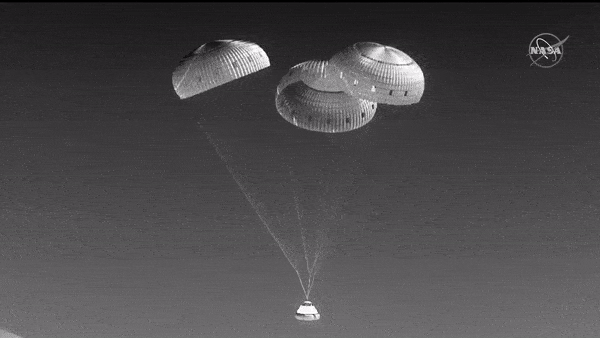
As the much-delayed Starliner program targets a crewed test flight date in February 2023 to send astronauts to the International Space Station, a filing by maker Boeing Wednesday (Oct. 26) with the U.S. Securities and Exchange Commission (SEC) announced a charge of $195 million in its fiscal third quarter. That brings total losses in the program of $883 million.
The company blamed operational (post-certification) mission timeline delays for the new charge, noting previously Boeing was assuming a 2024 timeline and that has been pushed back. "The three future post certification missions ... are now assumed to be completed by 2026, based on NASA's revised launch plans," the company stated in its SEC filing.
Boeing's "picture-perfect" uncrewed Orbital Flight Test 2 concluded with a safe touchdown on May 25, following a much more troubled Orbital Test Flight 1 that finished in 2019 without reaching the ISS.
Related: Boeing's Starliner OFT-2 spacecraft test flight for NASA in amazing photos
Video: Ride aboard Boeing's Starliner astronaut taxi
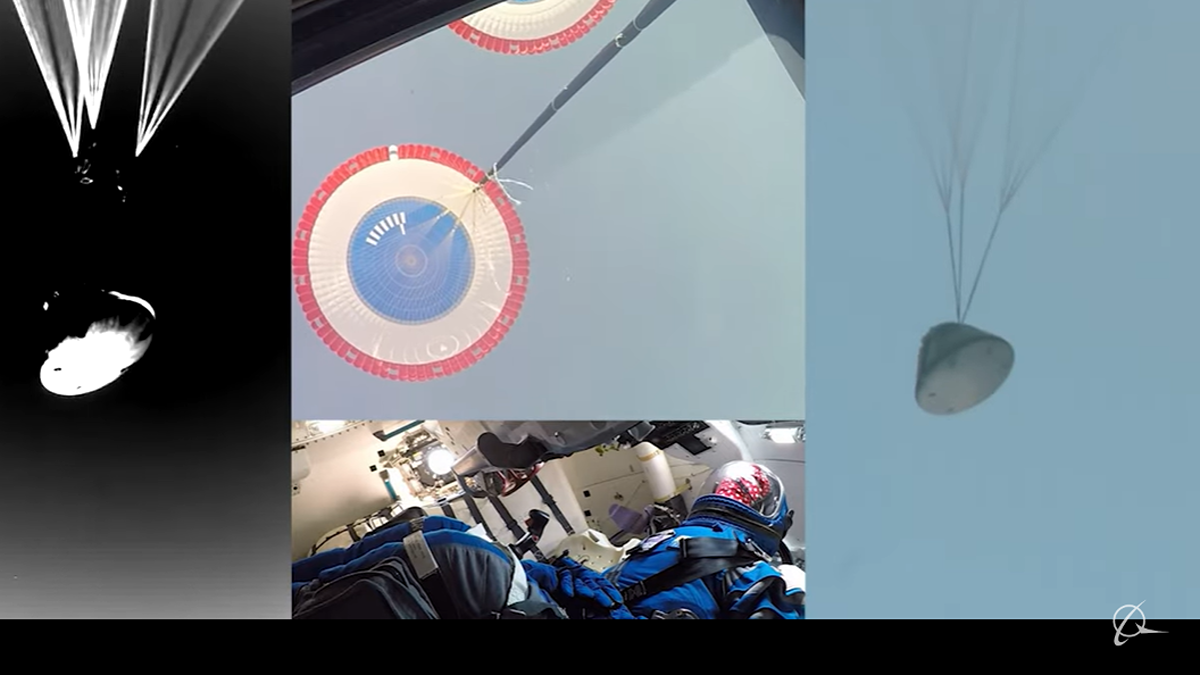
A new video from Boeing's uncrewed test flight of Starliner shows the grande finale of Orbital Test Flight-2, which flew to the International Space Station and back.
Starliner's final flight minutes on May 25 show up to four camera views, with the entire sequence uploaded on YouTube.
Read more: Ride aboard Boeing's Starliner astronaut taxi as it returns to Earth in this video
Boeing Starliner's 1st NASA astronaut delayed to February 2023

Boeing's first flight of its Starliner spacecraft for humans will wait a few more months. The flight will now launch no earlier than February 2023 due to the need to address issues identified on Orbital Flight Test-2 (OFT-2).
Post-flight reviews revealed four main issues, Mark Nappi, Starliner vice president and program manager at Boeing, said during today's call, which will push Starliner past its expected launch of December 2022.
Read more: Boeing Starliner's 1st astronaut flight for NASA delayed to February 2023
Starliner lands safely, wrapping up OFT-2 test mission

Boeing's Starliner capsule landed safely at White Sands Missile Range in New Mexico today (May 25) at 6:49 p.m. EDT (2249 GMT), wrapping up its uncrewed Orbital Flight Test 2 (OFT-2) mission to the International Space Station. Read our touchdown story.
The six-day-long OFT-2 was a key hurdle that Boeing had to clear before NASA certifies Starliner to carry astronauts. Certification is not guaranteed at this point, however; NASA and Boeing teams still need to analyze the data gathered during the mission.
Starliner now in view
Tracking cameras in the air and on the ground have caught their first glimpses of Starliner as it returns to Earth, picking up views of the capsule today (May 25) about eight minutes before its planned 6:49 p.m. EDT (2249 GMT) touchdown.
Starliner hits Earth's atmosphere
Starliner began feeling the effects of Earth's atmosphere today (May 25) at 6:33 p.m. EDT (2233 GMT), hitting the air at about 17 times the speed of sound. The capsule remains on track for a touchdown at New Mexico's White Sands Missile Range at 6:49 p.m. EDT (2249 GMT).
Starliner conducts de-orbit burn
Starliner conducted a 58-second de-orbit burn today (May 25) at 6:05 p.m. EDT (2205 GMT) as planned, NASA officials said. The burn slowed Starliner's velocity by 285 mph (459 kph), keeping the capsule on track for a touchdown in New Mexico at 6:49 p.m. EDT (2249 GMT). A few minutes after the burn wrapped up, Starliner jettisoned its service module, another milestone that occurred right on schedule.
Starliner headed back to Earth
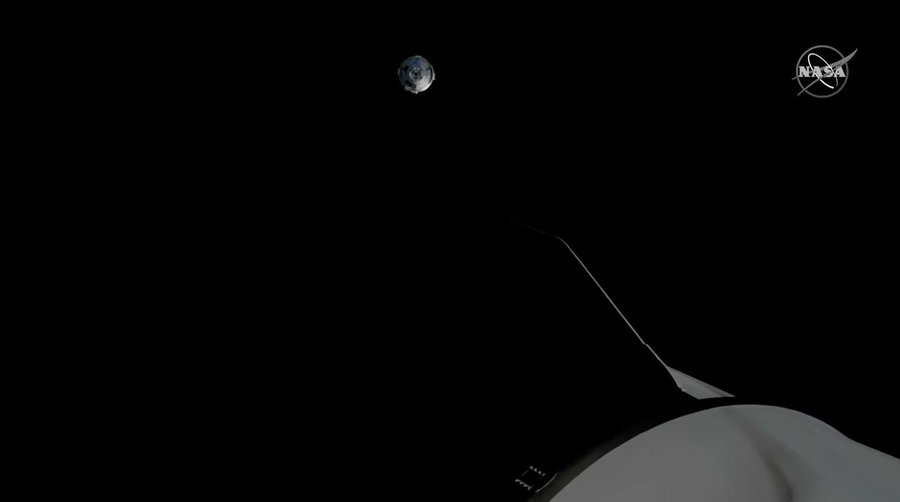
The Starliner OFt-2 spacecraft is headed back to Earth for a planned landing at White Sands Space Harbor in New Mexico at 6:49 p.m. EDT (2249 GMT).
You can watch Starliner's landing live on Space.com, courtesy of NASA TV, beginning at 5:45 p.m. EDT (2145 GMT).
At 6 p.m. EDT (2200 GMT), Starliner will fire its primary thrusters in a deorbit maneuver to begin its descent back to Earth. The spacecraft will jettison its service module and turn its heat shield to the front to protect itself from the searing heat of reentry.
As it descends, Starliner will fly on a northeastern trajectory that brings it over the Pacific Ocean, Baja California and Mexico on the way into New Mexico.
The ground track for the @BoeingSpace #Starliner spacecraft shows it entering Earth's atmosphere above the Pacific Ocean then traveling northeast for a landing in New Mexico on Wednesday at 6:49pm ET. pic.twitter.com/YR51TPNmq0May 25, 2022
Starliner undocks from space station

Boeing's Starliner OFT-2 spacecraft successfully undocked from the International Space Station and is preparing to return to Earth.
Starliner undocked from a front-facing port on the station's U.S.-built Harmony module at 2:36 p.m. EDT (1836 GMT) as both spacecraft sailed 257 miles above northern Singapore.
Starliner will fly around the space station before departing the orbiting laboratory and heading back to Earth. It is due to land in the desert of White Sands Space Harbor in New Mexico.
Starliner to leave space station today
Boeing's Starliner is on track for its return to Earth today, and will begin its journey home with an undocking from the International Space Station at 2:36 p.m. EDT (1836 GMT).
You can watch the undocking live at Space.com, courtesy of NASA TV.
Here's a timeline of what to expect today:
- 2 p.m. EDT (1900 GMT): NASA/Boeing Starliner undocking webcast begins
- 2:36 p.m. EDT (1836 GMT): Starliner OFT-2 undocking from ISS
- 5:45 p.m. EDT (2145 GMT): NASA/Boeing Starliner deorbit and landing webcast begins
- 6:05 p.m. EDT (2205 GMT): Deorbit burn
- 6:49 p.m. EDT (2249 GMT): Landing
- 9 p.m. EDT (0200 GMT): Post-landing press conference.
Astronauts close Starliner's hatch ahead of Wednesday departure

Astronauts on the International Space Station (ISS) closed the hatch connecting the visiting Boeing Starliner capsule to the orbiting lab today (May 24) at 3 p.m. EDT (1900 GMT). The milestone moment came as the two spacecraft were zooming 262 miles (422 kilometers) over Belgium, NASA commentators said during a hatch-closure webcast.
Starliner isn't ready to leave the ISS just yet, however. The uncrewed capsule is scheduled to depart on Wednesday (May 25) at 2:36 p.m. EDT (1836 GMT) and land in the New Mexico desert about four hours later.
ISS astronauts to bid farewell to Starliner today

Astronauts on the International Space Station (ISS) will make some farewell remarks about Boeing's visiting Starliner capsule today (May 24) at 12:15 p.m. EDT (1615 GMT). They then plan to close the hatches between the two spacecraft at 1:55 p.m. EDT (1755 GMT). You can watch the action live here at Space.com, courtesy of NASA.
Starliner isn't ready to depart the ISS just yet, however. The spacecraft is scheduled to detach from the orbiting lab tomorrow afternoon (May 25) and return to Earth a few hours later, at 6:49 p.m. EDT (2249 GMT), wrapping up its six-day Orbital Flight Test 2 mission.
Boeing's Starliner open for business on ISS

Astronauts aboard the International Space Station have opened up the Starliner spacecraft and taken their first look inside.
NASA astronaut Robert Hines was the first to enter Starliner after opening its hatch at 12:04 p.m. EDT (1604 GMT). He was followed by crewmate Kjell Lindgren and the pair quickly set up ventilation hoses, cameras and other gear inside.
They also met Starliner's only crewmember, the mannequin Rosie the Rocketeer, who made the trip up in the commander's seat on Starliner.
Starliner will spend about five days docked at the space station while astronauts measure its environment conduct tests to measure its performance at the station.
It's opening day for Starliner on ISS

Astronauts on the International Space Station will open Boeing's first Starliner to visit the station today (May 21), one day after its arrival to the orbiting lab.
The hatches between the two spacecraft are scheduled to be opened at 11:45 a.m. EDT (1545 GMT), with NASA's live webcast of the event beginning at 11:30 a.m. EDT (1530 GMT). You can watch the hatch opening on Space.com's homepage.
In the meantime, check out these spectacular photos of Starliner as seen by astronauts during the docking on Friday.
Docking! Boeing's Starliner arrives at ISS
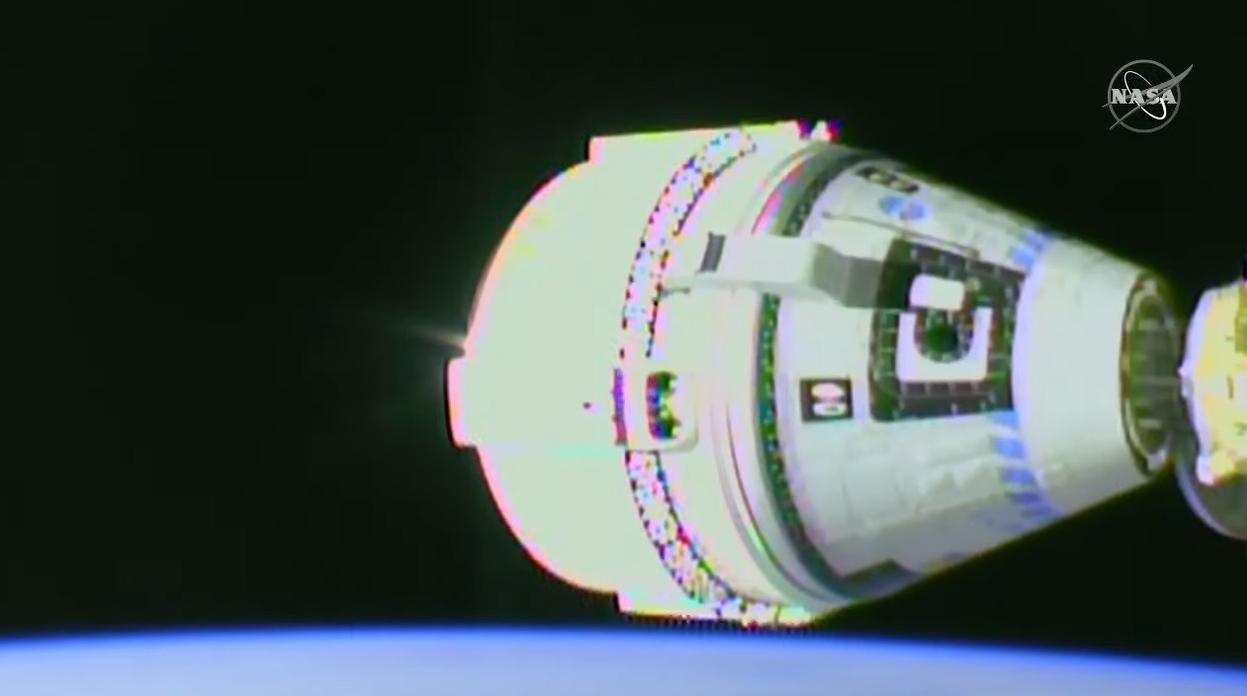
Boeing's Starliner successfully docked at the International Space Station at 8:28 p.m. EDT (0028 GMT May 21) as both craft sailed 271 miles above the South Indian Ocean.
The docking came just under 22 hours after the spacecraft launched toward the station on an Atlas V rocket.
Starliner is the second commercial spacecraft designed to ferry astronauts to reach the space station after SpaceX's Crew Dragon spacecraft. This is Boeing's first Starliner docking at the station.
NASA will hold a press conference at 9:30 p.m. EDT (0230 GMT May 21) to discuss today's docking success. You can follow that press conference on the Space.com homepage.
New Starliner docking time: 8:46 pm ET (0046 GMT)
Boeing and NASA are now targeting 8:46 p.m. EDT (0046 GMT) to dock Starliner OFT-2 to the International Space Station. That is the end of tonight's docking window.
"We do expect to make this window," Mission Control just told the ISS crew.
Starliner docking delayed for system reset
Boeing flight controllers have delayed Starliner's docking at the International Space Station another 30 minutes in order to reset the spacecraft's NASA Docking System. They'll need to retract Starliner's docking ring and reset it to clear an issue with the system, NASA officials said.
A new exact docking time will be determined once the docking system is reset.
Starliner docking delayed again
Flight controllers have reported "a small issue" with the docking system on Boeing's Starliner spacecraft, delaying tonight's docking a bit more.
A new docking time is expected shortly.
Starliner just 10 meters from ISS

Boeing's Starliner is now holding about 10 meters away from the space station as flight controllers prepare for its final approach.
The spacecraft has a new docking time of just after 8 p.m. EDT (0000 GMT), with a final thruster maneuver set for 7:57 p.m. EDT (2357 GMT).
Starliner docking time delayed to 2nd opportunity

Boeing and NASA flight controllers have waved off the first docking opportunity for Starliner OFT-2 and are now targeting a second, backup opportunity that would call for the spacecraft to fire its thrusters for final approach at 7:53 p.m. EDT (2353 GMT).
That means Starliner will not dock at its initially planned time of 7:10 p.m. EDT (2310 GMT). A new docking time is set for 7:57 p.m. EDT (2357 GMT).
Starliner on approach to space station
Boeing's Starliner is now on approach to the International Space Station to make its way to a point about 10 meters away from its docking port as flight controllers assess its tracking data and performance.
A short while ago, flight controllers gave Starliner a go to proceed after a hold to study why the spacecraft appeared to be in a position that was not at the center of its planned approach. The controllers confirmed that the position mismatch was a false indication and Starliner was in the proper position.
Starliner conducts "approach and retreat" maneuver

Starliner has conducted an "approach and retreat" maneuver, notching another milestone on the path toward its planned docking with the International Space Station less than an hour from now.
"After coming within 180 meters of @Space_Station, #Starliner performed an automatic retreat to 200 meters. The capsule has shown its ability to back away from the station in a controlled and timely manner and hold at an expected location," Boeing representatives said via Twitter this afternoon (May 20).
Docking is expected to occur around 7:10 p.m. EDT (2310 GMT). Learn more in our docking preview.
Starliner flies around space station — twice
Boeing's Starliner capsule continues to check off its pre-docking milestones on its uncrewed OFT-2 flight test to the International Space Station (ISS).
The spacecraft successfully completed two "inbound flyaround maneuvers" this afternoon (May 20), Boeing representatives announced via Twitter. The notching of such milestones keeps Starliner on target to dock with the ISS around 7:10 p.m. EDT (2310 GMT). Learn more in our docking preview story.
Starliner now visible from International Space Station
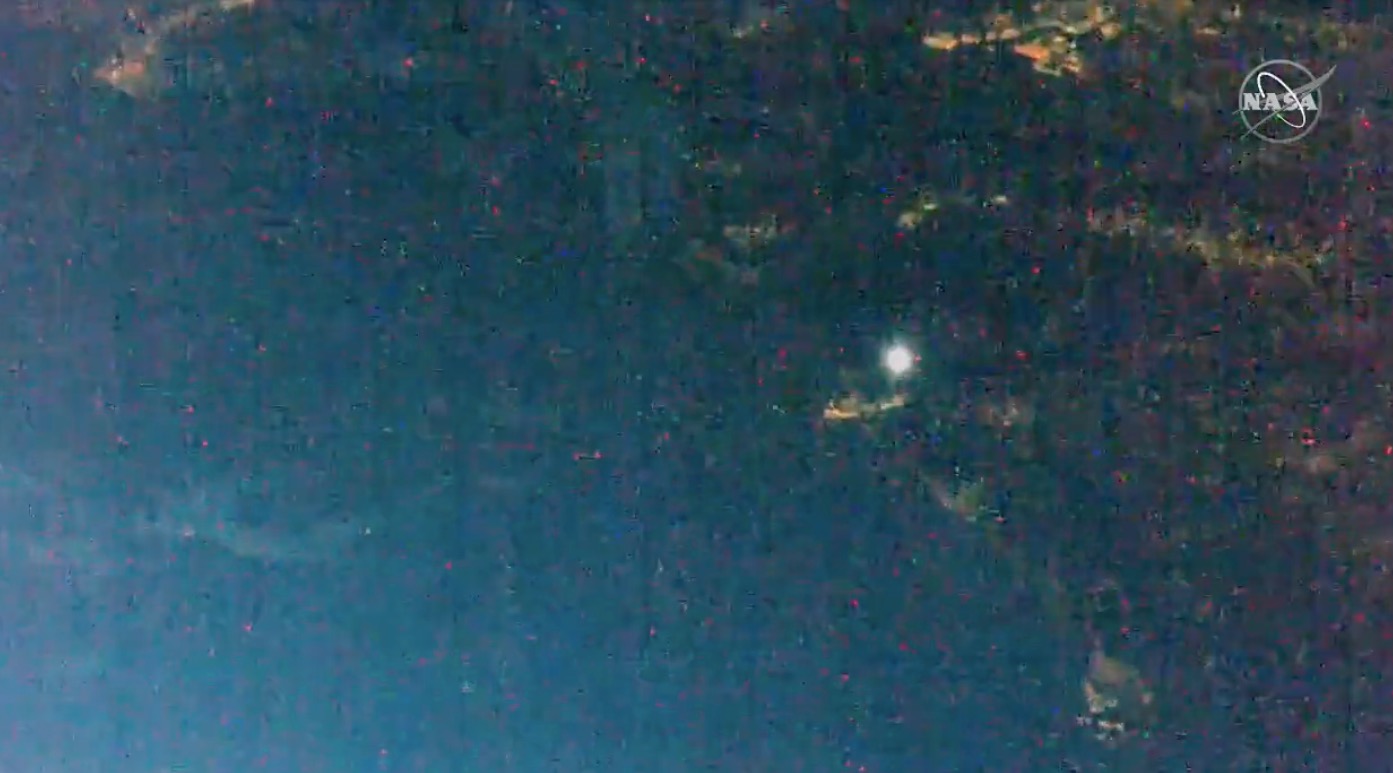
Astronauts aboard the International Space Station have caught their first glimpse of Boeing's Starliner capsule.
Starliner is headed for a docking with the orbiting lab today (May 20) at around 7:10 p.m. EDT (2310 GMT), a huge part of the spacecraft's uncrewed Orbital Flight Test-2 (OFT-2) mission. And Starliner has now come within view of the station.
"She’s here! Only a small dot for now, but soon she will knock at our door. #Starliner #OFT2," the European Space Agency's Samantha Cristoforetti, who arrived at the ISS last month on SpaceX's Crew-4 mission for NASA, said via Twitter today at 4:36 p.m. EDT (2036 GMT).
You can learn more in our Starliner docking preview.
Starliner acing in-orbit tests so far, Boeing says

Boeing's Starliner capsule has been performing well since it reached orbit on its uncrewed OFT-2 flight test to the International Space Station, company representatives say.
The capsule, which launched Thursday evening (May 19), is scheduled to dock with the orbiting lab today (May 20) around 7:10 p.m. EDT (2310 GMT). Starliner has been conducting a number of tests en route to the ISS, and they've all gone well, according to Boeing.
"Flight control teams continue to learn more about the vehicle and about how it is operating in space, and it continues to perform well as it makes its way toward the station," company representatives said in an emailed statement this afternoon. "The Guidance, Navigation and Control (GN&C) systems are performing nominally. Flight software is executing as designed. Power generation is positive."
Teams are investigating "off-nominal behavior" in a thermal cooling loop, the statement added, but Starliner continues to maintain a stable temperature despite that issue.
The statement also shed some light on the failure of two Starliner thrusters during the capsule's orbital insertion burn yesterday, glitches that the capsule overcame by firing up a backup thruster.
"The teams have concluded that a chamber drop in pressure caused the [thruster] cutoff," the statement added. "That system operated normally during all of the propulsion system demonstrations, and with redundancies in place, does not pose a risk to the rest of the flight test."
Starliner docking with ISS around 7:10 pm ET today: Watch it live

Boeing's Starliner capsule is scheduled to dock with the International Space Station today (May 20) around 7:10 p.m. EDT (2310 GMT), a huge milestone for the spacecraft and its OFT-2 mission.
Coverage of rendezvous and docking activities begins today at 3:30 p.m. EDT (1930 GMT), and you can watch it live here at Space.com, courtesy of NASA. Read our docking preview story.
Docking day for Boeing's Starliner OFT-2

It's docking day for Boeing's Starliner OFT-2 space capsule, which is chasing the International Space Station for a planned rendezvous later tonight.
The Starliner spacecraft is launched into orbit last night (May 19) and is scheduled to dock itself at the station tonight at 7:10 p.m. EDT (2310 GMT). You can watch the Starliner docking live starting at 3 p.m. EDT (1900 GMT).
In a press conference late Thursday, Boeing and NASA officials said the Starliner OFT-2 spacecraft is doing well in space on its uncrewed flight. During an orbital insertion burn to enter orbit about 31 minutes after liftoff, two of the capsule's 12 big thrusters failed but the remaining 10 were able to compensate for the loss.
Boeing engineers are investigating the glitch, but it is not expected to pose an issue for today's planned docking.
NASA, Boeing Starliner launch briefing at 9 pm ET

NASA and Boeing will hold a press conference at 9 p.m. EDT (0200 GMT on May 19) to discuss tonight's successful launch of the Starliner OFT-2 test flight to the International Space Station.
You can watch the press conference live on Space.com.
Speaking during tonight's briefing will be:
- Kathryn Lueders, associate administrator, NASA Space Operations Mission Directorate
- Steve Stich, manager, NASA’s Commercial Crew Program
- Joel Montalbano, manager, NASA’s International Space Station Program
- Mark Nappi, vice president and program manager, Boeing Commercial Crew Program
- John Elbon, chief operating officer, United Launch Alliance
Boeing's Starliner reaches orbit!

Boeing's Starliner spacecraft has successfully reached orbit after a short 45-second orbital insertion burn.
"We have a good orbital insertion burn. Starliner is in a good, stable circular orbit on its way to the International Space Station," a Boeing's Josh Barrett says.
The spacecraft is now on a 20.5-hour trip to the International Space Station, with docking set for Friday, May 20, at 7:10 p.m. EDT (2310 GMT).
You'll be able to watch Starliner's approach and docking at the space station live beginning at 3 p.m. EDT (1900 GMT). Here's how to watch the Starliner mission online.
Boeing's Starliner separates from Atlas V rocket

Boeing's Starliner OFT-2 capsule has successfully separated from its Centaur rocket upper stage and is now flying in space on its own.
Up next is a critical orbital insertion burn to reach its intended orbit. That engine burn is scheduled for about 31 minutes after liftoff (that's about 7:25 p.m. EDT or 2325 GMT).
Liftoff! Atlas V rocket launches Starliner OFT-2

Liftoff! The Atlas V rocket carrying Boeing's Starliner spacecraft for NASA has launched off its pad and is heading to space.
The rocket has successfully separated its booster from its twin-engine Centaur upper stage, which is currently powering upward with the Starliner spacecraft.
All systems continue to perform well.
Atlas V rocket "GO" for Boeing Starliner launch
The United Launch Alliance, Boeing and NASA have conducted one final poll and found the Atlas V rocket and Starliner OFT-2 spacecraft "GO" for launch.
All systems are performing well for this second attempt to launch the OFT-2 mission after delays last year due to valve issues, that have since been resolved.
Starliner space capsule on internal power

Boeing's Starliner space capsule for the OFT-2 test flight has switched to internal power for today's launch. Liftoff remains on track for a 6:54 p.m. EDT (2254 GMT).
All systems remain "go" for today's launch.
The Crew Access Arm at Starliner's Space Launch Complex 40 pad at Cape Canaveral Space Force Station has moved clear of the spacecraft and Atlas V rocket.
Boeing's Starliner OFT-2: Weather looks good for launch
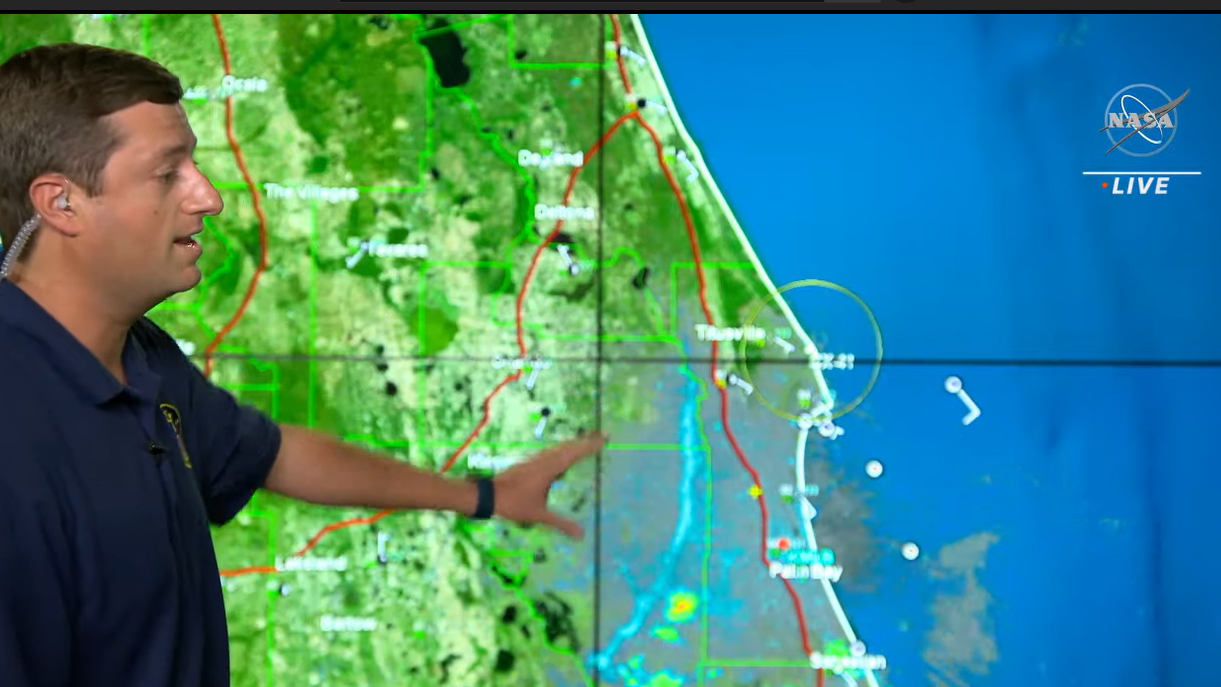
With less than hour remaining until launch, Boeing's Starliner OFT-2 test flight on its Atlas V rocket has clear skies for launch.
Weather officials say conditions offer a 90% chance of good weather for launch.
A final launch readiness poll is coming soon.
Starliner's Atlas V fueled for launch

The Atlas V rocket carrying Boeing's Starliner OFT-2 space capsule is now fully fueled for its launch tonight at 6:54 p.m. EDT (2254 GMT).
"The United Launch Alliance (ULA) Atlas V rocket that will lift the vehicle into space is now fueled and configured for stable replenish," Boeing reported in a status update. "Additionally, the pad team has been cleared to re-enter Space Launch Complex-41 for spacecraft closeout operations."
The Starliner spacecraft's service module oxidation valves completed their final cycling check before launch and are working well. Stuck valves in that system are what stalled the July 2021 launch attempt for Starliner.
"The valves have been cycled seven times since propellant loading at the factory," Boeing wrote in an update. "As part of standard prelaunch ops, at about L-30 minutes, they’ll be opened for flight."
Viewers in southeastern US may see OFT-2 launch: Visibility map
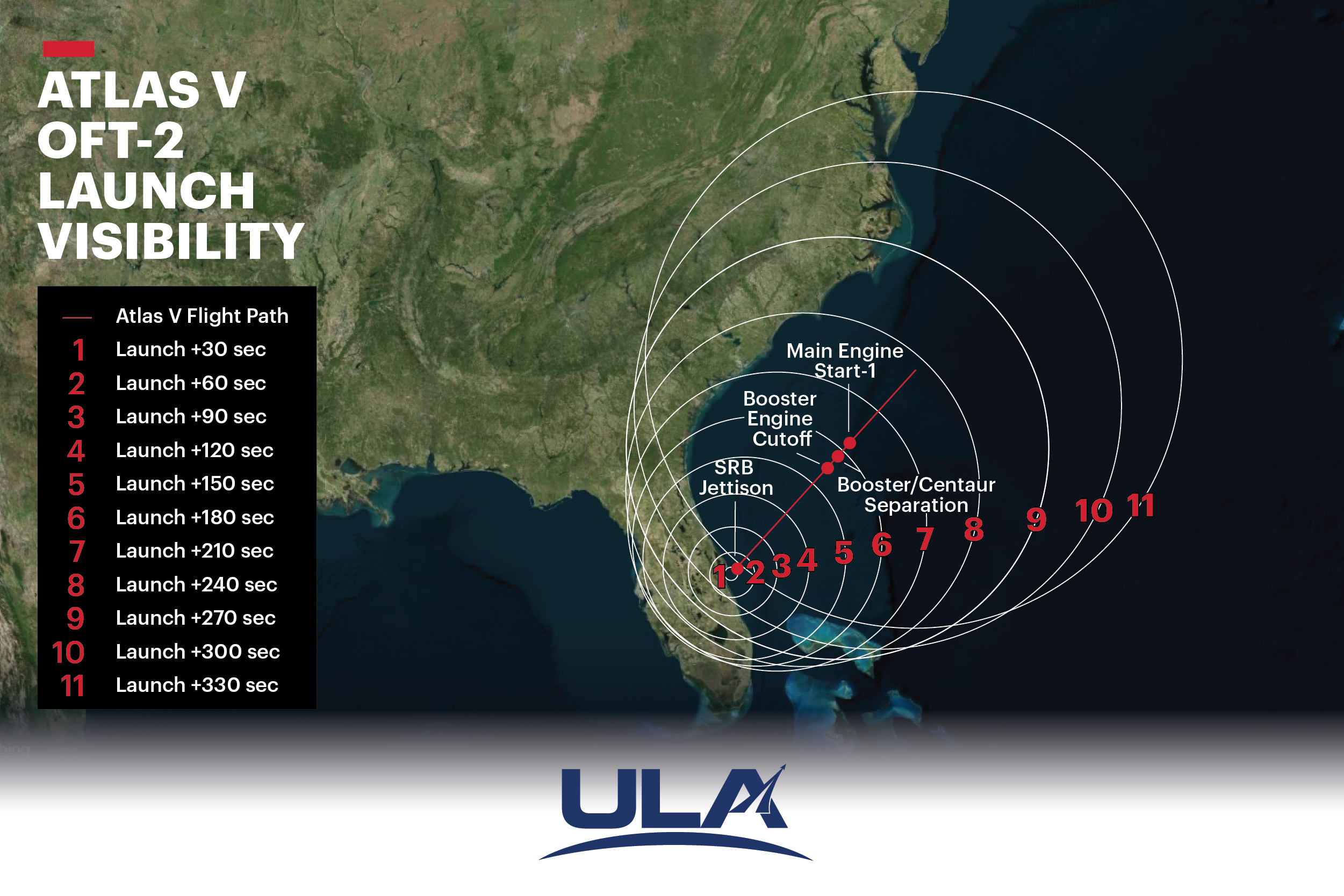
If you live near the Atlantic coast in the southeastern United States, you might be able to catch a glimpse of a United Launch Alliance (ULA) Atlas V rocket carrying Boeing's Starliner capsule into the sky this evening (May 19) on its OFT-2 mission.
OFT-2 is scheduled to launch at 6:54 p.m. EDT (2254 GMT) from Florida's Cape Canaveral Space Force Station. Will you be able to see it? Read more in our launch-visibility story.
Launch day for Boeing Starliner OFT-2

It is launch day once again for Boeing's Starliner OFT-2 test flight to the International Space Station, with the launch time set for 6:54 p.m. EDT (2254 GMT) tonight.
Boeing's second Starliner spacecraft and its Atlas V rocket will launch on an uncrewed test flight to space station to prove its ready to carry astronauts to and from the station for NASA. The mission has been a longtime coming.
A December 2019 test flight launched into orbit but failed to reach the station. That was OFT-1. Then, in July 2021, an attempt to launch OFT-2 was stalled due to stuck thruster valves. Now, Boeing has addressed the valve issue and is ready to try again.
The United Launch Alliance, which built the Atlas V rocket, rolled the booster out to its pad at Space Launch Complex 40 at the Cape Canaveral Space Force Station yesterday. The first NASA astronauts who will launch on Starliner - Sunita Williams, Mike Fincke and Butch Wilmore - told reporters Wednesday that they're excited to watch Starliner launch on its OFT-2 mission since it will set the stage for their own Crew Flight Test-1 mission in the near future.
NASA's webcast for the launch will begin at 6 p.m. EDT (2200 GMT). You can watch the Boeing Starliner launch live through liftoff. Here's a webcast schedule from NASA:
Thursday, May 19
- 6 p.m. EDT (2200 GMT): Launch coverage begins NASA's Boeing Orbital Flight Test-2 from the Cape Canaveral Space Force Station, Fla.
- 6:54 pm EDT (2254 GMT): Launch, with coverage continues through the orbital insertion engine firing for Starliner approximately 31 minutes after liftoff.
- 9 p.m. EDT (0200 GMT on May 20): NASA's Boeing Orbital Flight Test-2 post-launch news conference (time subject to change)
Friday, May 20
- 3:30 p.m. EDT (1930 GMT): Coverage of the rendezvous and docking at the International Space Station
- 7:10 p.m. EDT (2310 GMT): Docking
Saturday, May 21
- 11:30 a.m. EDT (1530 GMT): Coverage of the opening of the hatch to NASA's Boeing Orbital Flight Test-2 vehicle at the International Space Station
- 11:45 a.m. EDT (1545 GMT): Hatch opening, coverage will continue through welcoming remarks by the crew)
- 1 p.m. EDT (1700 GMT): Welcoming remarks by the Expedition 67 crew on the arrival of NASA's Boeing Orbital Flight Test-2 vehicle to the International Space Station
-- Tariq Malik
Starliner on track for May 19 launch of OFT-2 mission

Boeing's Starliner astronaut taxi is all set for a Thursday (May 19) launch of OFT-2, a crucial uncrewed flight to the International Space Station.
Boeing, NASA, and United Launch Alliance, which is supplying OFT-2's Atlas V rocket, held a launch readiness review for the mission today (May 17), and everything went well. "It was short; it was very clean. There's really no issues that ULA, Boeing or NASA are working for the launch coming up," Steve Stich, manager of NASA's Commercial Crew Program, said during a press conference today. Read our full story here.
NASA, Boeing prelaunch news conference today
NASA and Boeing will hold a prelaunch news conference today, May 17, at 12 p.m. EDT (1600 GMT) to discuss launch plans for Boeing's OFT-2 Starliner test flight to the International Space Station and you'll be able to watch it live online.
The press conference will be carried live on NASA TV and you can watch the briefing on the Space.com homepage at start time. Speaking in the conference will be:
- Steve Stich, manager, NASA’s Commercial Crew Program
- Dana Weigel, deputy manager, NASA’s International Space Station Program
- Mark Nappi, vice president and program manager, Boeing Commercial Crew Program
- Gary Wentz, vice president, Government and Commercial Programs, ULA
- Will Ulrich, launch weather officer, U.S. Space Force, 45th Weather Squadron, Space Launch Delta 45
Boeing's Starliner OFT-2 mission is scheduled to launch on an Atlas V rocket on May 19 from Cape Canaveral Space Force Station in Florida. Liftoff is set for 6:54 p.m. EDT (2254 GMT).
The mission is an uncrewed test flight to the International Space Station to prove out the Starliner spacecraft's systems ahead of a crewed commercial flight for NASA.
Starliner is 'go' for May 19 launch to space station

NASA has cleared Boeing's Starliner capsule for a planned May 19 launch on Orbital Flight Test-2 (OFT-2), a crucial uncrewed mission to the International Space Station.
The decision came after a lengthy flight readiness review on Wednesday (May 11). Read more here.
OFT-2 was originally supposed to launch in August 2021, but technicians discovered that 13 of the 24 oxidizer valves in the capsule's propulsion system were stuck. Diagnosing and troubleshooting this issue ended taking about eight months.
Starliner will return to the factory for troubleshooting
We've determined #Starliner will return to our factory for deeper-level troubleshooting of four propulsion system valves. With @NASA, we've decided to stand down for this launch window to make way for other national priority missions.More: https://t.co/oycWeRz156 pic.twitter.com/UzCZN66451August 13, 2021
Boeing's Starliner is heading back to the processing facility for additional checks, and the OFT-2 mission is still delayed indefinitely.
"We've determined #Starliner will return to our factory for deeper-level troubleshooting of four propulsion system valves. With @NASA, we've decided to stand down for this launch window to make way for other national priority missions," Boeing tweeted today. You can read the full update from Boeing here.
Starliner OFT-2 update coming today

NASA and Boeing are holding a news conference today at 1 p.m. EDT (1700 GMT) to discuss the latest delays of the Starliner OFT-2 mission. You can listen to the teleconference live here at Space.com, courtesy of NASA.
Read more: Stuck valves on Boeing's Starliner keep critical space station test flight on hold
Back inside for Starliner
The @ULALaunch Atlas V rocket with the Starliner spacecraft on top has returned to the Vertical Integration Facility. @BoeingSpace will now power up Starliner, allowing the vehicle to receive commands and providing the teams with real-time data: https://t.co/JpWB0LKHxQ pic.twitter.com/Dk3nZSSirYAugust 5, 2021
Boeing's Starliner atop its United Launch Alliance Atlas V rocket has rolled back into the Vertical Integration Facility at Cape Canaveral Space Force Station to allow technicians to continue troubleshooting a glitch that interfered with Tuesday's scheduled launch. Read more.
Boeing postpones launch indefinitely
We're not proceeding with #Starliner launch tomorrow. Our team cycled the Service Module propulsion system valves and is taking time to gather data for next steps. We've ruled out software as a cause for the unexpected position indications.More: https://t.co/2fCrIY7uc8 pic.twitter.com/8dvlfpAOneAugust 4, 2021
Boeing has decided to step back from the Wednesday (Aug. 4) launch target for Starliner after finding a valve in the propulsion system in an improper position and not being able to quickly identify the cause of the anomaly.
"We're going to let the data lead our work," John Vollmer, vice president and program manager for Boeing’s Commercial Crew Program, said in a statement. "Our team has worked diligently to ensure the safety and success of this mission, and we will not launch until our vehicle is performing nominally and our teams are confident it is ready to fly."
Read our story about the indefinite launch delay here.
Launch is scrubbed
Per Boeing's Twitter: "We're confirming today's #Starliner Orbital Flight Test-2 launch is scrubbed. More details soon."
Countdown enters planned hold
Starliner's Atlas V rocket has just entered a planned four-hour hold at T-minus four minutes before launch, United Launch Alliance reports on Twitter. The lengthy hold is to simulate the procedures before an astronaut crew enters the spacecraft. While that's not happening today (this launch is an uncrewed test), ULA says it plans to simulate crew ingress procedures during Orbital Test Flight-2.
Launch forecast at 50 percent
United Launch Alliance reports that the weather forecast stands at 50-50 for the time of the Atlas V launch with Boeing's Starliner on board, at 1:20 p.m. EDT (1720 GMT). That said, the current weather has "no threat of lightning for the Blue Team's entrance into the launch pad and for their work" at Cape Canaveral Space Force Station, ULA said on Twitter.
Fueling complete
United Launch Alliance sent a Twitter update informing that the fuelling of the Atlas V rocket is complete. The company says the rocket is so far on track to launch on time at 1:20 p.m. EDT (1720 GMT), although of course that will also depend on weather.
Launch preparations continue
Filling of the #AtlasV first stage with 48,800 gallons of super-cold liquid oxygen is underway. The LOX will be consumed with the RP-1 kerosene loaded into the rocket after rollout yesterday to power the main engine. pic.twitter.com/egAk3LbKOrAugust 3, 2021
Launch is coming soon! United Launch Alliance personnel are busy filling the rocket's first stage with fuel about 5 hours before lift-off.
NASA astronauts are excited for the launch
NASA astronauts can't wait to see Starliner fly today. The mission marks a crucial milestone before they and their colleagues will be able to give the capsule a spin for themselves. Read more.
Atlas V and Starliner are "now in launch position"
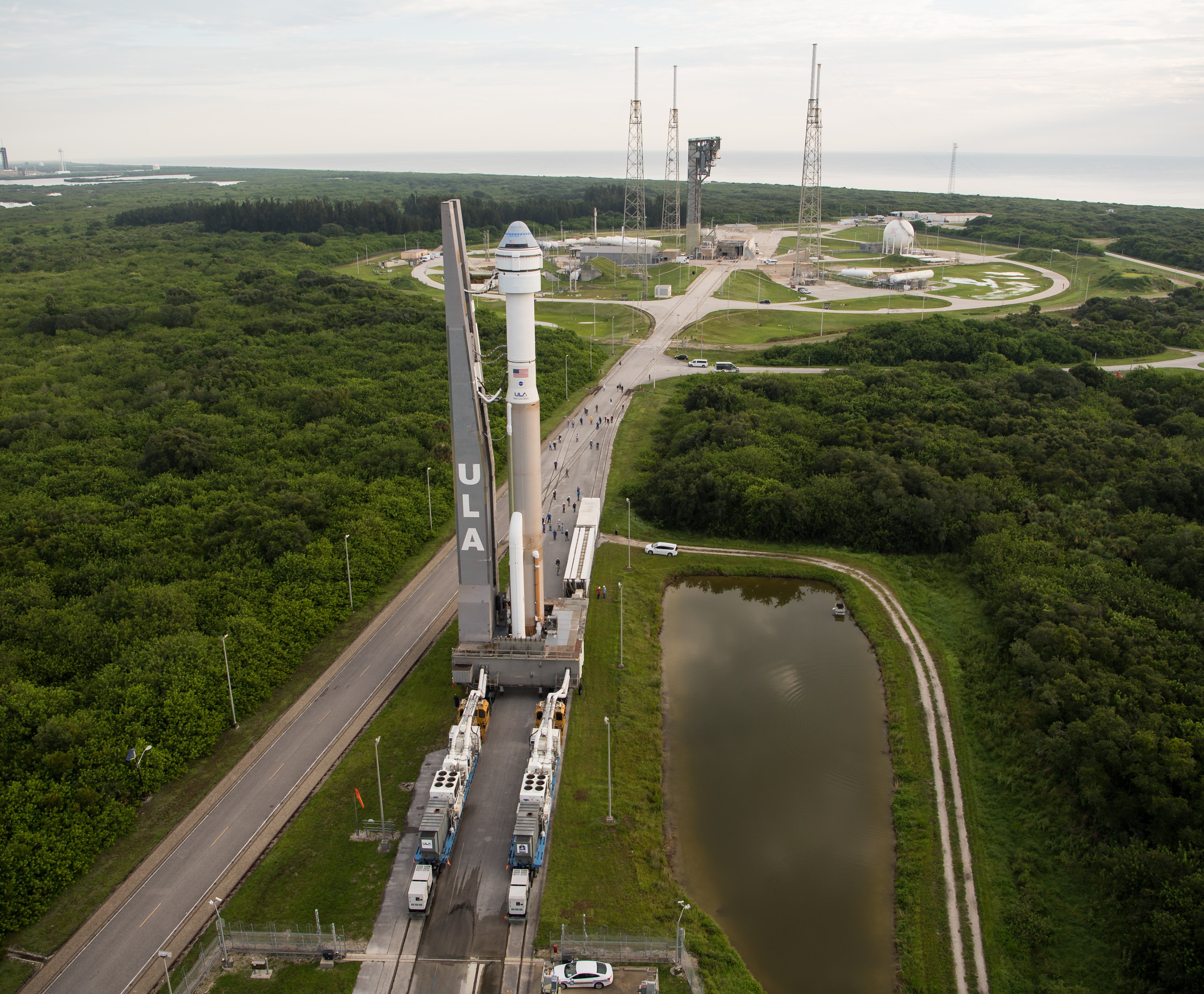
The Atlas V rocket and Starliner spacecraft returned to the launch pad early this morning after waiting out the launch delay inside the Vertical Integration Facility. See photos of their second rollout here.
"Boeing’s CST-100 Starliner is now in launch position on Space Launch Complex 41 at Cape Canaveral Space Force Station in Florida," Boeing said in an update. "The Starliner, which is mated to the top of a United Launch Alliance (ULA) Atlas V rocket, rolled to the launch pad on train tracks at a speed of about 1 mph from the Vertical Integration Facility, located about 1 mile from the launch site."
You can preview the OFT-2 mission in a new video animation below:
Back out to the pad!
We're rolling to the pad for #Starliner's Orbital Flight Test-2! Our team along with @ulalaunch and the #AtlasV that will boost Starliner into orbit are rolling the rocket and spacecraft to the launch pad on Space Launch Complex-41 this morning ahead of tomorrow's launch. pic.twitter.com/vp7k84ER0TAugust 2, 2021
After spending the weekend inside in case of bad weather, Starliner and its Atlas V rocket are now headed back out to the launch pad in preparation for tomorrow's flight.
Weather forecast: 60% go for launch
Meteorologists with the U.S. Space Force's 45th Weather Squadron are now predicting a 60% chance of favorable weather for liftoff on Tuesday.
"The primary weather concerns for launch day are the cumulus cloud rule, lightning rule and thick cloud rule violations during the instantaneous launch window," NASA officials wrote in an update.
🚀🌟 In two days, @BoeingSpace's Starliner spacecraft will launch to the @Space_Station! Weather is currently 60% "GO" for liftoff.Starliner is scheduled to dock to the orbiting laboratory on Wednesday, Aug. 4 at about 1:37 p.m. ET: https://t.co/4u8v2sU0Ij pic.twitter.com/GRnfa5RECzAugust 1, 2021
Forecasting launch day's weather
Will bad weather interfere with Tuesday's launch? Maybe, or the rocket could blast off before the storms roll in. Read more.
OFT-2 in pictures
While we wait out the launch delay, check out the full story of OFT-2 in photos with this gallery.
Starliner heads back inside

With launch delayed to no earlier than Tuesday (Aug. 3) and bad weather expected to hit the Space Coast, the Starliner capsule and its Atlas V rocket headed off the launch pad for shelter. Read more here.
New launch date announced
NASA officials announced during a news conference that Starliner will now target launch on Tuesday (Aug. 3) at 1:20 p.m. EDT (1720 GMT). If that launch date holds, the capsule will arrive at the International Space Station on Wednesday (Aug. 4). Read more.
Starliner launch delayed
NASA and Boeing have delayed Friday's planned launch of the uncrewed Starliner OFT-2 mission and are establishing a new launch date, according to a NASA statement. The delay comes after Russia's Nauka module briefly tilted the International Space Station by firing its thrusters in an unplanned maneuver that you can read about here.
We'll update with a new launch date as soon as possible.
"Success in spaceflight is achieved by millions of elements coming together and working in perfect harmony," Boeing officials wrote in a statement about the delay. "That's the nature of our business, and that requires patience. We stand ready to launch the CST-100 Starliner when the time is right, as we support NASA on the International Space Station."
Starliner and Atlas V roll out
ULA's 172-foot (52 meters) Atlas V rocket, with Starliner secured on top, left the Vertical Integration Facility today (July 29) and rolled out to its launch pad, Space Launch Complex 41 at Cape Canaveral Space Force Station in Florida. Read our rollout story here.

L-1 Day!
What's the big deal with this launch? Don't worry, we've got you covered. Check out a deep dive on Boeing's bumpy ride to the launchpad and brush up on every aspect of the mission, from what's on board to what comes next.
Starliner spends one more night at the VIF

Boeing just shared a new photo of its Starliner spacecraft inside the Vertical Integration Facility at Cape Canaveral Space Force Station as the Atlas V rocket awaits its delayed rollout to the launchpad, now scheduled for 8 a.m. EDT (1200 GMT) tomorrow (Thursday, July 29).
"Storms rolled in, so Starliner didnt roll out," Boeing tweeted today. "#Starliner and #AtlasV are safe in the @ulalaunch Vertical Integration Facility and ready to roll tomorrow morning."
Atlas V rocket rollout delayed

The United Launch Alliance (ULA) and Boeing had originally planned to transport the Atlas V rocket for the OFT-2 mission to the launchpad this morning, but the rollout has been postponed until Thursday (July 29), beginning at 8 a.m. EDT (1200 GMT).
"The delay is due to an internet service provider outage that could not be resolved before the onset of predicted weather exceeding operational constraints. The OFT-2 launch, planned for Friday, July 30, at 2:53 p.m. EDT, remains on track," NASA officials wrote in a blog post.
Speaking of weather, currently the forecast is looking only 40% favorable for Starliner's planned launch on Saturday. "At this time, the probability of violation remains at 60%, with the primary concerns being the Cumulus Cloud, Surface Electric Fields, and Lightning Rules," the U.S. Space Force's 45th Weather Squadron said in the latest weather update.
Boeing's plan for the flight
Catch up on the plan for Starliner's second uncrewed launch with this video from Boeing.
Starliner OFT-2 prelaunch briefing starts now!
NASA and Boeing are about to begin today's prelaunch news conference for the Starliner OFT-2 mission. The briefing begins at 1 p.m. EDT (1700 GMT), and you can watch that live here on Space.com, courtesy of NASA TV.
Launch weather update

The launch weather forecast for Friday's planned launch of the Starliner OFT-2 mission currently predicts only a 40% chance of acceptable conditions for liftoff, according to an update from the U.S. Space Force's Space Launch Delta 45 Weather Squadron.
NASA and Boeing officials will hold a prelaunch news conference for OFT-2 tomorrow (July 27) at 1 p.m. EDT (1700 GMT). You can watch that live here on Space.com, courtesy of NASA TV.

The CST-100 Starliner capsule has passed its flight readiness review (FRR) for the upcoming liftoff, which will kick off the uncrewed Orbital Flight Test 2 (OFT-2) mission to the station, NASA and Boeing representatives announced today (July 22). Read the full story here.
Over the weekend, engineers mated the Starliner spacecraft to its Atlas V rocket, marking a key milestone ahead of the mission's launch next week. See the photos here.
